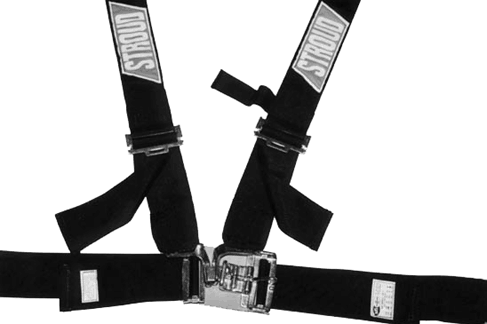|

Words and photos by Wayne
Scraba
7/10/03

"Who cares about safety
equipment?" If you race, you should. All too
often, safety equipment is the very last thing
on your mind when thinking about a racecar.
To tell you the truth, when it comes to your
personal safety, it's easy to become complacent
("It'll never happen to me. . .").
THE REALITY OF DECELERATION
If any vehicle is decelerated, a specific amount of gravitational force is exerted which in turn requires an opposite effort to keep the driver planted in the seat. This gravitational force is commonly referred to as a "G" force. Every human being has one "G" force holding his or her feet on Mother Earth. A single "G" force is equal to your respective weight. If you weigh 170 pounds, that's the weight of the "G" force that you exert. If you weigh 250 pounds, that's the corresponding weight of your specific "G" force. Given the laws of gravity, there are additional "G" forces acting upon your body as you accelerate and decelerate a vehicle. If your particular car is accelerating forward at one "G", there is a one "G" force (equal to your weight) pushing you rearward in the seat. Now, if that same car decelerates at the rate of two "G's", then there will be a two "G" force attempting to push you forward. Right out of the seat.
Pretty simple stuff. But when you start factoring
in the typical "G" forces present in a quick
car accelerating or decelerating, it becomes
apparent that you cannot remain positioned in
a seat without support. For example, the NHTSA
has released a set of figures for passenger
cars involved in a 35 mile per hour head on
crash into a solid object. These figures have
been obtained by way of instrumented "dummies"
seated in production vehicles propelled into
a concrete barrier. The dummy decelerates at
a force equal to between twenty and forty "G's"
for a period of time equaling fifty to one hundred
milliseconds. Although the time frame is critical
(for various reasons we will not involve ourselves
with in this article), it is the massive "G"
loading, even in a 35 mph crash that quickly
becomes apparent. Look at the following simple
mathematical calculations using both a 170 pound
driver and a 250 pound driver as examples:
| G-force |
170-lb
at deceleration |
250-lb
at deceleration |
| 20 G's |
20 x 170
= 3,400 |
20 x 250
= 5,000 |
| 30 G's |
30 x 170
= 5,100 |
30 x 250
= 7,500 |
| 40
G's |
40
x 170 = 6,800 |
40
x 250 = 10,000 |
|
It doesn't take a rocket scientist to figure
out that the forces present in an accident at
a relatively slow overall speed are incredible.
G-force numbers ranging to five tons are trying
to pull you out of the seat belt and at the
same time, trying to stretch the belt, bend
the belt hardware and pull the mounts free from
the vehicle. And remember, this is from an instrumented
crash at 35 miles per hour.

|